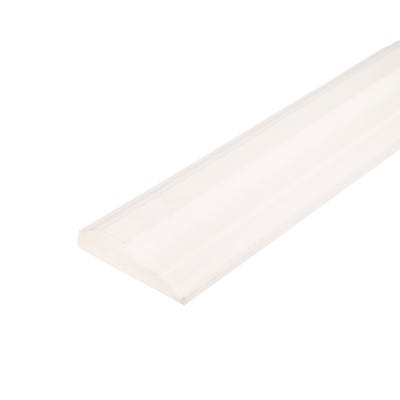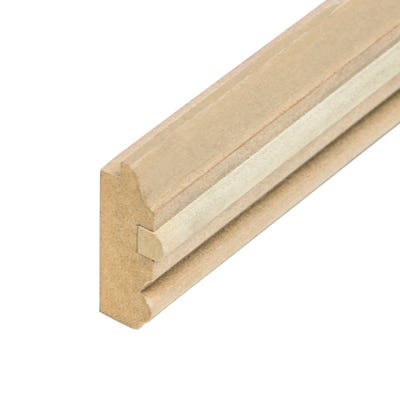Now Shopping By: 1 Applied Filters
What are timber mouldings?
Timber mouldings are trim pieces made from wood or synthetic materials, designed to add decorative details and protect surfaces. Mouldings are available in various shapes and materials like hardwood, softwood, MDF, and plastic.
They are most commonly used in interior design to cover gaps and imperfections or to enhance doors, walls, furniture, and ceilings.
Most decorative mouldings undergo finishing processes (such as denibbing) and are cut with machinery to create smooth surfaces that are perfect for painting, staining, or varnishing.
What are timber mouldings used for?
Timber mouldings are both practical and decorative. They can be used to:
- Frame doors and windows for a more refined appearance.
- Create wall panelling to add depth and character to interiors.
- Soften the transition between walls and ceilings with coving.
- Conceal gaps at the junctions of walls and floors for a neat finish.
- Protect walls from scuffs and damage caused by furniture and foot traffic.
- Enhance interiors with geometric flair with features like ogee shapes and angled edge moulding.
What is the difference between beading and moulding?
Beading and moulding are both types of decorative trim, but they serve different functions.
Beading is a narrow trim used to enhance panelled doors and furniture, providing a subtle decorative touch.
Moulding refers to a wide range of trim types, such as coving, dado rails, and skirting boards, that create more prominent architectural details.
What is the best type of decorative moulding for you?
There are many different types of decorative mouldings and each has its own purpose. Below you can find a description of what each of the wood mouldings we supply does.
- Angle trims:
- These trims have a thin width, making them a discreet option that seamlessly joins the edges between walls and floors.
- Beading:
- These decorations follow a circular beaded pattern and add a touch of embellishment to your doors, furniture, and panelling.
- Coving:
- Coving is a classic feature and a popular choice to soften the angle between walls and ceilings for a much neater transition, allowing your interior to blend seamlessly.
- Dado rails:
- These are protective features that can be fitted to walls at various heights to prevent damage from your furniture, while also introducing a traditional charm to the room.
- Dowels:
- These are cylindrical wooden rods used in structural applications and joinery and are also used to create wall features like shelving and curtain rods. They can also be used to add decorative texture, making your walls more visually interesting.
- Handrails:
- These rails offer support and safety for any staircases in your home and are a great pick for complementing timeless interior designs.
- Head drips:
- Head drips are a preventative measure for directing water away from doors and windows to effectively reduce the likelihood of moisture damage in your home.
- Panels:
- These accessories are typically structured in square or rectangular patterns to frame walls, doors, and furniture, adding a subtle character to any room. They can either be painted to match your walls for a satisfying blend, or in a different colour for a pop of contrast.
- Picture rails:
- These supportive features are typically installed between your wall and ceiling for the hanging of artwork. While primarily intended to serve a functional purpose, they can also add a fashionable touch to the room.
- Quadrants:
- These sections are usually thicker than angle trims and are used for filling gaps between your floor and walls for a flawless finish. They are well-suited to protecting the walled edges of wooden staircases.
- Scotias:
- Scotias are the thickest of angle trims and quadrants. They are intended to conceal expansion gaps in flooring and feature detailed, layered designs for an appealing look.
- Stair nosings:
- These are fixed onto the surface of staircase steps and often overhang slightly to reduce wear during use and to improve stair safety by adding grip.
- Stripwood:
- Stripwood is a versatile material for various construction and decorative applications. Some of its uses include framing mirrors, creating unique designs on walls, and for shelving features.
What are decorative mouldings made from?
Different materials are used to create mouldings, each offering unique advantages for specific applications.
- Hardwood and softwood:
- These provide strength, durability, and a timeless finish. These natural woods are ideal for a range of features around your home, including skirting boards, architraves, door frames, and decorative wall panels in living rooms and hallways. This material especially complements period-style homes.
- Medium-density fibreboard (MDF):
- MDF is smooth, easy to paint, and resistant to warping. It's an excellent choice for doors, window sills, wall panels, custom cabinetry, and shelving. MDF is a popular choice for budget-friendly projects or DIY home improvements.
- Moisture-resistant MDF:
- This MDF is specially treated to withstand humidity, making it perfect for kitchens, bathrooms, and other areas of your home that may be high in moisture. It's specifically well-suited for kitchen plinths, bathroom trims, and panels around sinks or bathtubs.
- Premium moisture-resistant high-density fibreboard (HDF):
- This material is exceptionally durable, making it ideal for heavy-duty applications in high-traffic areas. It's a great option for flooring transitions and staircases in busy homes or commercial spaces.
- Plastic and PVC:
- These mouldings are lightweight, moisture-resistant, and perfect for outdoor areas. Plastic and PVC are commonly used around windows and doors in bathrooms, exterior cladding, or for outdoor projects like decking and garden furniture. This material is a great contender for homes that experience significant dampness.
- Softwood fibre and resin composites:
- These materials combine strength and flexibility, making them ideal for decorative cornices, door surrounds, and ceiling features with traditional and classic designs. They’re also popular to use in public spaces like schools and hospitals, offering impact resistance and easy installation.



